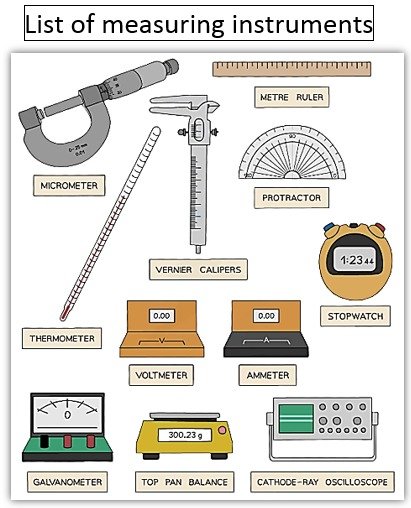List of measuring instruments
List of measuring instruments

Measuring instruments in physics
History of measuring instruments:
The history of measurement tools in physics goes back thousands of years, with the development of various tools and methods for quantifying and understanding the physical world. Here is a brief overview of the historical development of measuring instruments in physics:
Old tools:
Ancient Egyptians used simple measuring devices such as knotted ropes to determine lengths and angles for building purposes.
The ancient Greeks developed the astrolabe to measure astronomical positions and angles.
The Roman Empire used a device called a thunderbolt to detect and level.
Middle Ages and Renaissance:
During the Middle Ages, more sophisticated measuring instruments such as the dial and the cross were developed and used for astronomical observation and navigation.
The Renaissance period saw significant advances in measuring instruments. Galileo Galilei's experiments with inclined planes and pendulums used simple measuring instruments and time.
18th and 19th century:
More accurate measuring instruments appeared in the 18th century. Instruments such as the sextant, theodolite and chronometer were used for navigation, surveying and timekeeping.
The field of thermometry developed with the invention of mercury thermometers by Gabriel Fahrenheit and Anders Celsius:
During this period, electrical measuring instruments began to appear. The Leyden jar, an early form of capacitor, was used to measure electric charge, and the galvanometer was developed to detect and measure electric currents.
20th century and later:
The 20th century brought enormous advances in measuring instruments, driven by advances in technology and scientific understanding.
The development of electronic instruments has revolutionized measurement in physics. Devices such as oscilloscopes, voltmeters, ammeters and multimeters have become commonplace in laboratories.
Particle detectors and accelerators have been developed to study elementary particles and natural forces.
Sophisticated instruments such as spectrometers, interferometers and calorimeters have become essential for accurate measurements in various fields of physics.
The invention of digital computers and data acquisition systems has further expanded the capabilities of measuring instruments, enabling more complex measurement and data analysis.
INSTRUMENTS WHICH ARE USES FOR MEASUREMENT
Today, measurement tools continue to evolve as technology advances, allowing scientists to explore new frontiers of physics and make increasingly accurate and precise measurements. From nanoscale instruments to large-scale observatories, the history of measurement instruments in physics demonstrates humanity's desire to understand and quantify the natural world.
List of measuring instruments:
In physics, measuring instruments play a vital role in the quantitative observation and analysis of various physical phenomena. These tools allow scientists to make accurate measurements and collect data to support scientific theories and principles. Here are some commonly used measurement tools in physics:
Ruler/caliper:
These tools are used to measure lengths and distances with high accuracy. A ruler usually gives measurements in centimeters or inches, while a vernier caliper can measure both internal and external dimensions more accurately.
Stopwatch:
A stopwatch is a device used to measure time intervals with high accuracy. It is often used in experiments related to the timing of events or measuring the duration of physical processes.
Thermometer:
Thermometers are used to measure temperature. They can be based on different principles, such as liquid thermometers, digital thermometers or infrared thermometers. Thermocouples and resistance temperature sensors (RTDs) are other types of temperature sensors used in more specialized applications.
Scales/Balances:
Scales and scales are used to measure mass. They can range from simple mechanical scales to more sophisticated electronic scales. A scale measures mass by comparing an unknown mass to known masses, and a scale measures the weight of an object based on the force of gravity acting on it.
Voltmeter:
The voltmeter is used to measure the electrical potential difference or voltage. It is usually connected in parallel with the component or circuit to be measured.
Ammeter:
An ammeter measures the electrical current flowing through a circuit. It is connected in series with the component or circuit under test.
Spectrometer:
Spectrometers are used to measure and analyze the properties of light. They can measure parameters such as wavelength, frequency, intensity and polarization of light. Different types of spectrometers include prism spectrometers, grating spectrometers, and Fourier transform spectrometers.
Oscilloscope:
An oscilloscope is a device used to view and measure electrical signals. Displays a graph of voltage versus time, allowing scientists to analyze waveforms, frequencies, amplitudes, and other characteristics of electrical signals.
particle detectors:
Particle physics uses a variety of specialized instruments to detect and measure subatomic particles. Examples are Geiger-Muller counters, cloud chambers, bubble chambers and particle accelerators such as the Large Hadron Collider (LHC).
Geiger-Muller Counter:
Used to detect and measure ionizing radiation, such as alpha particles, beta particles, or gamma rays. They are widely used in nuclear physics, radiation monitoring, and radiation protection.
Accelerometer:
Measures acceleration, often used in research, navigation systems, and mobile devices.
Magnetic Compass:
Used to measure the direction of the Earth's magnetic field.
GPS (Global Positioning System):
Used to determine precise location and navigation on the Earth's surface.
Laser Interferometer:
Laser interferometers are used to measure extremely small displacements or changes in length. They are based on the interference pattern created by the splitting of the laser beam and its recombination after reflection from the test object.
These are just a few examples of the wide range of measurement tools used in physics. Depending on the specific field and phenomenon being studied, scientists may use a combination of these instruments or use more specialized equipment to make accurate measurements. In reality, measuring instruments play a fundamental role in virtually every field of physics, enabling scientists to collect precise data and validate theories through experimental observations.
What's Your Reaction?





















